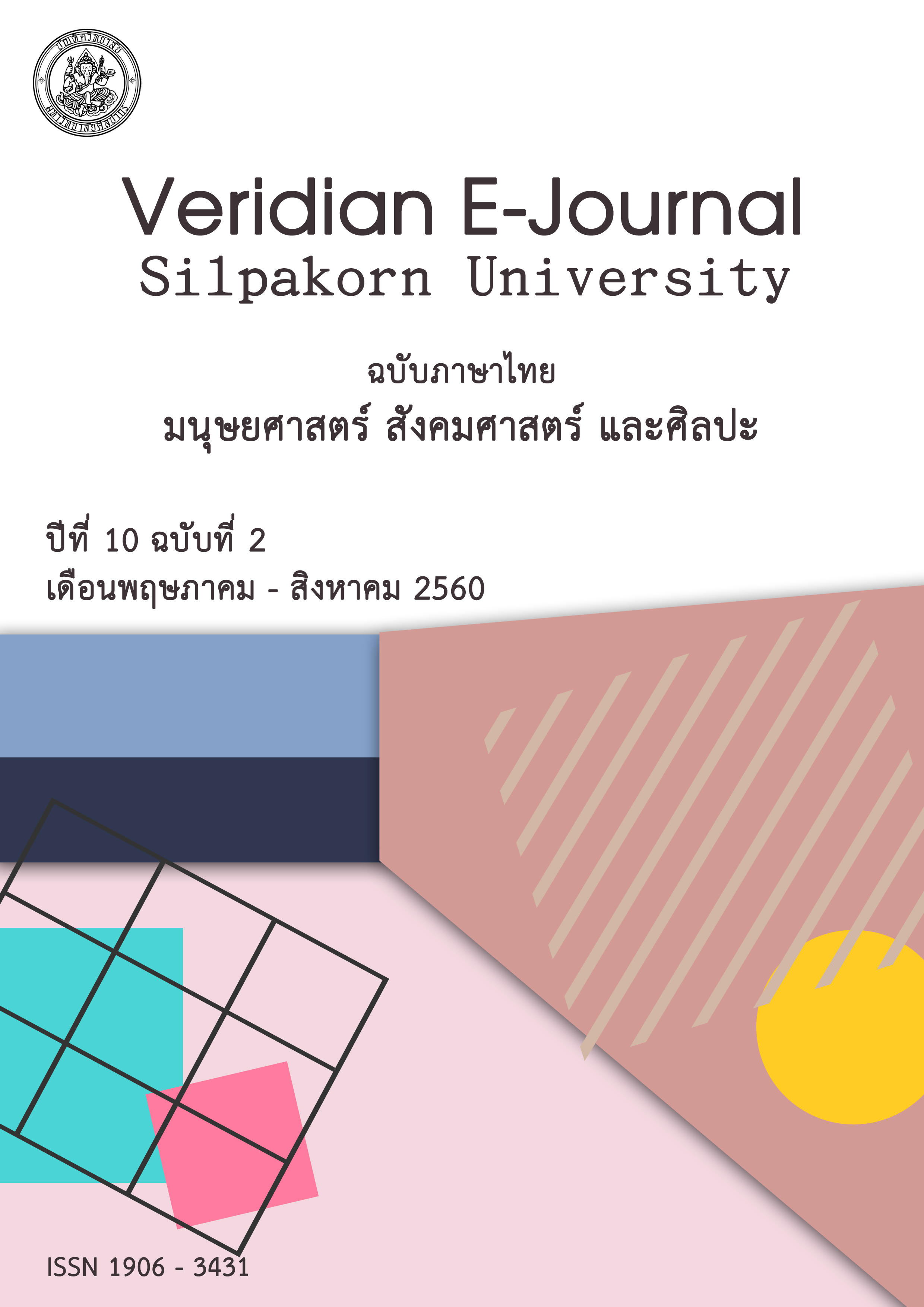การพัฒนารูปแบบการสอนที่เน้นภาระงานเพื่อส่งเสริมความสามารถในการอ่านภาษาจีน เพื่อความเข้าใจ สำหรับนักศึกษาปริญญาตรี
Main Article Content
Abstract
การวิจัยครั้งนี้มีวัตถุประสงค์เพื่อ 1) สร้างและหาประสิทธิภาพรูปแบบการสอนที่เน้นภาระงานเพื่อส่งเสริมความสามารถในการอ่านภาษาจีนเพื่อความเข้าใจให้ได้ตามเกณฑ์ 80/80 2) ประเมินประสิทธิผลของการพัฒนารูปแบบการสอนที่เน้นภาระงานเพื่อส่งเสริมความสามารถในการอ่านภาษาจีนเพื่อความเข้าใจ และ3) ขยายผลรูปแบบการสอนที่พัฒนาขึ้น กลุ่มตัวอย่างในการวิจัยครั้งนี้ ได้แก่ นักศึกษาสาขาการสอนภาษาจีนในฐานะภาษาต่างประเทศ ชั้นปีที่ 2 จำนวน 30 คน ที่ลงเรียนรายวิชาการอ่านภาษาจีน 1 ภาคการศึกษาที่ 1/2559 ซึ่งได้มาจากการเลือกแบบเจาะจง เครื่องมือที่ใช้ในการวิจัยประกอบด้วย รูปแบบการสอนที่เน้นภาระงาน คู่มือการใช้รูปแบบการสอนที่เน้นภาระงาน แผนการจัด การเรียนการสอน แบบทดสอบความสามารถในการอ่านภาษาจีนเพื่อความเข้าใจ แบบประเมินความเข้าใจในบทอ่านจากชิ้นงาน แบบประเมินพฤติกรรมการใช้กลวิธีการอ่านภาษาจีน แบบสอบถามความพึงพอใจของนักศึกษาที่มีต่อรูปแบบและแบบสะท้อนคิดของนักศึกษาที่มีต่อรูปแบบวิเคราะห์ ข้อมูลโดยการหาค่าเฉลี่ย ค่าเบี่ยงเบนมาตรฐาน ค่าทีแบบไม่อิสระ(t-test for dependent samples) และการวิเคราะห์เนื้อหา ผลการวิจัยพบว่า 1.รูปแบบการสอนอ่านภาษาจีนที่เน้นภาระงานเพื่อส่งเสริมความสามารถในการอ่านสำหรับนักศึกษาปริญญาตรีมีชื่อว่า “4A Model” (รูปแบบโฟร์เอ) ประกอบด้วยกระบวนการ 4 ขั้น ได้แก่ 1) ขั้นกระตุ้นก่อนการเรียน (Activating Prior Learning: A) 2) ขั้นประยุกต์ใช้กลวิธีและตรวจสอบความเข้าใจ (Applying Strategies and Checking for Comprehension: A) 3) ขั้นปฏิบัติภาระงาน (Acting on the Task: A) และ 4) ประเมินชิ้นงานจากบทอ่าน (Assessing the Task: A) รูปแบบมีประสิทธิภาพเท่ากับ 86.76/98.00 2.ประสิทธิผลของรูปแบบพบว่า 1) หลังเรียนตามรูปแบบนักศึกษามีความสามารถในการอ่านภาษาจีนเพื่อความเข้าใจสูงกว่าก่อนเรียนอย่างมีนัยสำคัญทางสถิติที่ระดับ .05 2) นักศึกษามีพัฒนาการด้านความเข้าใจในบทอ่านจากชิ้นงานสูงขึ้นในช่วงระหว่างเรียนจากระดับมากเป็นระดับมากที่สุด โดยที่ระยะที่ 1 ระยะที่ 2 และระยะที่ 3 อยู่ในระดับมาก ระยะที่ 4 อยู่ในระดับมากที่สุด 3) มีพฤติกรรมการในการใช้กลวิธีการอ่านภาษาจีนสูงขึ้นและ 4) มีความคิดเห็นต่อกิจกรรมการเรียนรู้ตามรูปแบบอยู่ในระดับเห็นด้วยมาก 3.ในการขยายผลพบว่า หลังเรียนตามรูปแบบนักศึกษากลุ่มขยายผลมีความสามารถในการอ่านภาษาจีนเพื่อความเข้าใจสูงกว่าก่อนเรียน มีพัฒนาการด้านความเข้าใจในบทอ่านจากชิ้นงานสูงขึ้นจากระดับปานกลางเป็นระดับมาก มีพฤติกรรมในการใช้กลวิธีการอ่านภาษาจีนที่สูงขึ้น และมีความคิดเห็นต่อกิจกรรมการเรียนรู้ตามรูปแบบอยู่ในระดับเห็นด้วยมาก
This research aimed to 1) develop and find out the efficiency of a task-based Chinese reading model in order to promote reading ability of undergraduate students according to criteria 80/80, 2) evaluate the effectiveness of the developed model, and 3) extend the implementation of the developed model. The subjects were 30 of the second year undergraduate students in Chinese teaching major who enrolled in Chinese Reading 1 in the first semester of academic year 2016. These subjects were obtained by purposive sampling. The research instruments consisted of materials in teaching reading Chinese, teaching reading Chinese usage manuals, lesson plans, Chinese Reading comprehension evaluation form, opinion questionnaires for students, and reflection form for students toward teaching reading Chinese model. This study was analyzed by mean, standard deviation, t-test for dependent samples, and content analysis.The results were found as follows : 1.The developed model which was called “4A Model” consisted of 5 aspects: principles, objectives, instruction, evaluation, and implementation conditions. The implementation conditions were classified in to 4 stages: Activating Prior Learning: A, Applying Strategies and Checking for Comprehension: A, Acting on the Task: A, and Assessing the Task: A. 2.The efficiency of this model was 86.76/98.00.The effectiveness of the model was found that: (a) Students’ Chinese reading ability was significantly improved at .05 level of significance after learning with this model,(b) During learning, students had progressed on reading comprehension on tasks from high level at phases 1, 2 and3 to the highest level at phases 4, (c) Chinese reading strategies were markedly used by students, and (d) Students’ satisfaction toward the teaching Chinese reading model were at high level. 3.For extended implementation, it was found that students’ Chinese reading comprehension abilities after using the instruction model were significantly improved and higher than before using the model. Students also had progressed on reading comprehension on task from moderate to high level, while Chinese reading strategies progress were exposed. Moreover, students’ opinions toward the instruction of this model were at the high level.

